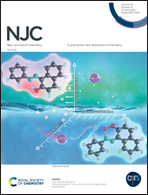Synthesis, structural characterization, docking studies and bioactivities of carbon monoxide release molecules based on triphenylphosphonium-glycyrrhetinic acid derivatives†
Abstract
As a gasotransmitter, carbon monoxide can induce tumor cell apoptosis by reversing the Warburg effect. Carbon monoxide-releasing molecules (CORMs) are a promising option for CO administration, but how to deliver the threshold concentration of CO into the tumor tissue remains a challenge. A series of novel targeted CORMs combining glycyrrhetinic acid (GA) derivative conjugates with a lipophilic mitochondriotropic triphenylphosphonium cation (TPP+) moiety were synthesized and evaluated for their antitumor activities. Among the complexes, complex 2 possessed excellent antitumor activities in HepG2 cells with IC50 values of 12.18 ± 4.66 μM compared with 5-FU. It caused the production of reactive oxygen species and reduced the mitochondrial membrane potential against HepG2 cells. Western blot analysis showed that complex 2 up-regulated the expression of the Bax protein and down-regulated the expression of Bcl-2, activated caspase-3, and HO-1. The docking study demonstrated that complex 2 can interact with the Bcl-2 protein through hydrophobic interaction and hydrogen bonds. The aforementioned results indicated that complex 2 triggered cell apoptosis through a mitochondrial pathway. These results suggest that the complexes may be promising anticancer agent candidates.



 Please wait while we load your content...
Please wait while we load your content...